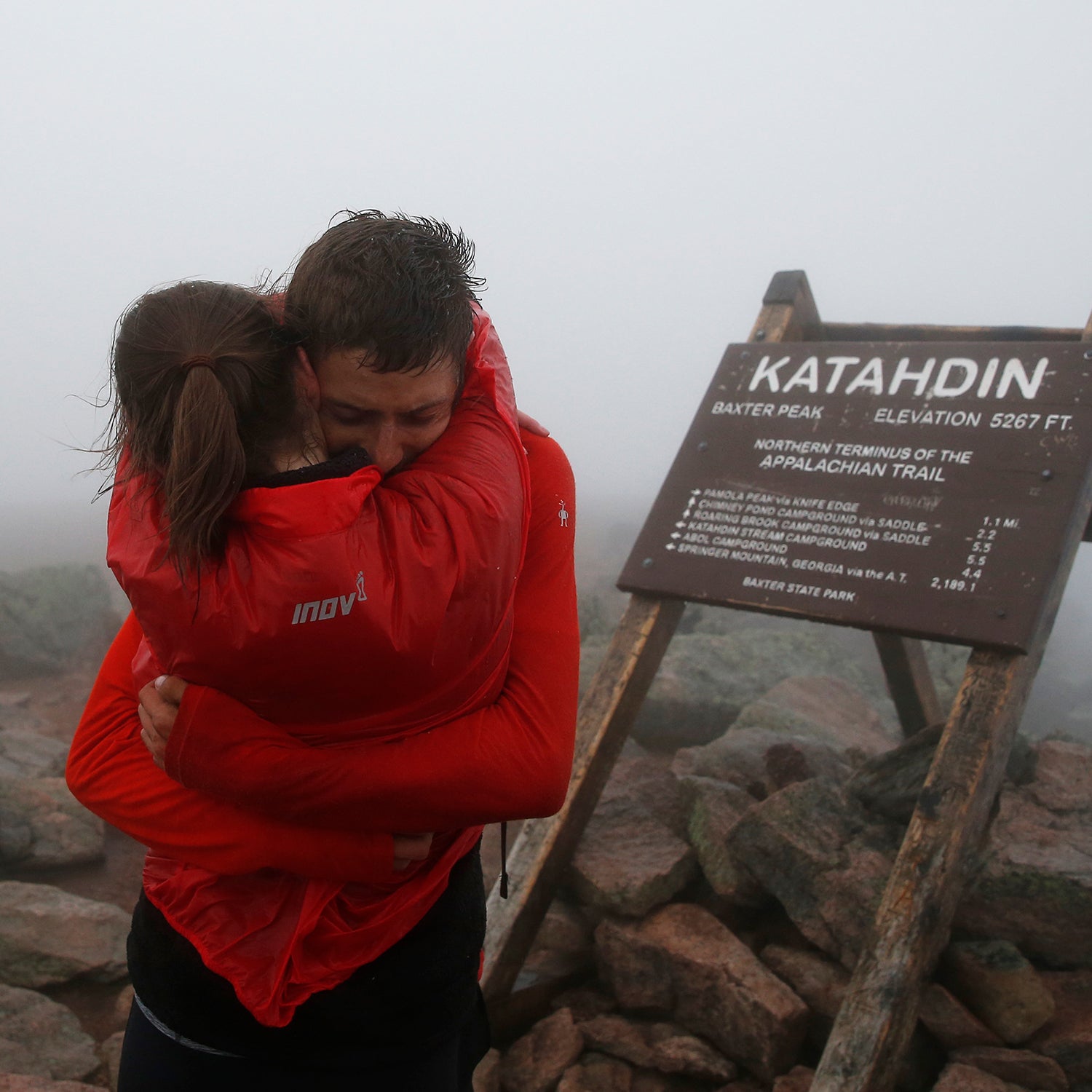Exactly a week after smashing the self-supported fastest known time record on the Appalachian Trail, Joe “Stringbean” McConaughy was fidgeting in the waiting room of a Boston-area sports medicine physician. He was, by his own admission, kind of a wreck: blisters and sores just about everywhere, strains and possible tears in both hamstrings, an infected foot, and an injury behind one knee that he thought was probably serious. Still, McConaughy, age 26, couldn’t help but brainstorm about his next feats—maybe he’d try to set a 100-mile track record, just to see what would happen. Or see if he could get a late entry into a 50-mile trail race near his house. Or find another qualifier for next year’s 100-mile endurance race, one of the toughest around.
“I keep thinking I’m in really good shape, even though I know I’m actually destroyed,” he laughed.
McConaughy first made a real name for himself as a distance runner while enrolled as a student at Boston College. He finished his course work in 2014. His graduation present to himself? An FKT attempt of the Pacific Crest Trail, even though he’d never run more than 20 miles in a day. McConaughy dedicated the run to his cousin, who died of cancer at age two, and raised $30,000 for cancer research along the way. (Both the fundraising and the FKT were the subject of , a documentary produced and directed by Jack Murphy and Michael Dillon.)
McConaughy beat the supported FKT on the Pacific Crest Trail that year—it took him 53 days, 6 hours, and 37 minutes—but the attempt took its toll. Three months later, he was doing more physical therapy than trail running.
“I didn’t enjoy it anymore,” says McConaughy. “I got chubby. My body was eating so much, and I wasn’t being active. When I did actually run, it felt miserable.”
Still, he couldn’t help but think about that FKT. He knew he could do 50 miles a day, the approximate pace required to beat the supported record on the Appalachian Trail, set two years ago by Scott Jurek and then bested by Karl Meltzer last September. Plus, resupplying on the AT is much easier than it is on the PCT. Maybe, then, he could break their records with a self-supported attempt. As audacious as that seemed, McConaughy figured it was worth a shot.
“I keep thinking I’m in really good shape, even though I know I’m actually destroyed.”
“It was crazy to think I was going up against Meltzer and Jurek. You read about them in books, which is enough to tell that they are some of the best, to say the least. These guys have all the pedigrees and all the support,” says McConaughy. “Still, at the end of the day, I thought I had a shot if I could figure out a resupply plan.”
It took McConaughy and his girlfriend, fellow ultrarunner Katie Kiracofe, four months and a lot of Excel spreadsheets to dial in the logistics. He did training runs with friends on sections of the AT and completed two ultramarathons in back-to-back weekends. (Murphy and Dillon documented that in their film, .)
Still, McConaughy hadn’t even seen most of the trail before he began. His parents flew out to wish him well as he started his attempt at Georgia’s Springer Mountain. And then it was all up to him.
In the end, McConaughy bested Meltzer’s time by more than 12 hours—completing the route in 45 days, 12 hours, and 15 minutes—even after losing nearly two days in the White Mountains to injuries and complications surrounding that infected foot. That’s a big part of what makes this dual record so significant, says Peter Bakwin, of , the clearinghouse for FKT attempts.
“Guys like Jurek and Meltzer run with a fanny pack or a hydration vest. Every ten miles, they come across their crew, who rub their legs while they sit in a chair eating food someone else has prepared. At night, they sleep in a bed and ice their injuries. Contrast that with Joe, who carried a 25-pound pack and set up his own camp and slept on the ground every night.”
Just how difficult the attempt would be became apparent to McConaughy from the start. He figures he sustained a noteworthy injury pretty much every day. Less than a week into his attempt, he developed rhabdomyolysis, a potentially life-threatening condition in which dead muscle fibers are released into the bloodstream, compromising kidney function and sometimes leading to cardiac arrest or organ failure.
Rhabdo, as it’s often called, is fairly common in the ultrarunning world and often first manifests as unusually dark urine. McConaughy initially hoped that he was just dehydrated, so he slowed his pace and upped his water consumption for a couple days. By the third day of symptoms, when his urine turned blood-red, McConaughy knew he was potentially in big trouble. He stopped at a stream and tried to chug water, but that was difficult with a persnickety filter. Eventually, two ultrarunners passed by, took one look at him, and offered him their salt tablets, which he readily accepted. He then tried walking and, eventually, jogging slowly on the trail. About an hour later, he overtook one of the runners, who he says had collapsed of heat exhaustion on the trail. McConaughy tended to him as best as he could, dousing the runner in water and trying to force him to eat. In time, he was joined by two ER doctors who were also hiking the trail.
“They elevated the runner’s legs and did all the things doctors know to do,” says McConaughy. “And while we waited for him to get well enough to stand, they told me all about how serious rhabdo really is.”
By the time the runner was back on his feet, McConaughy was ready to call it a day. He peeled off the trail and spent the evening having dinner in Hot Springs, North Carolina, where he could lick his wounds and regroup. “From the start, I was always injured, always knocked around from the trail. You don’t really factor that into your calculations before getting started,” he says.
By the third day of symptoms, when his urine turned blood red, McConaughy knew he was potentially in big trouble.
Then there was the psychological toll. It’s lonely in the wilderness. Friends and family had offered to meet him along the trail just to say hello, but McConaughy didn’t want to risk any claims that they were helping him. Controversy over recent self-supported attempts, he says, made him extra wary about the need to prove he’d received no assistance.
That’s one reason he also made the decision to grant Bakwin full access to his Spot, a satellite tracking device, which he figured would make validating his claim easier. He asked friends and family to keep track of it as well, and they’d text him whenever a couple of hours had gone by without an automatic update. That’d be the signal for him to start hitting a button that allows for manual location stamps and to take photos and videos, which he then posted .
“It was kind of frustrating,” says McConaughy. “You’re already concentrating on accomplishing the most challenging thing you’ve ever done. You’re out on the trail, you’re worrying about a million things and the 50 miles you have to finish, so a GPS isn’t really your first thought. But it’s the reality of what you have to do.”
Bakwin says McConaughy did a heroic job at validating his attempt—and set the bar steep for all those who will try to best him in the future.
Still, there have been some detractors who point out that McConaughy accepted those salt tablets from the ultrarunners. Others raised objections when he posted an Instagram that he’d ordered outside Sugar Grove, Virginia. The Partnership Shelter there is legendary for its pizza delivery, which regularly caters to thru-hikers, but detractors argued McConaughy was receiving assistance by availing himself of the delivery service. They pointed to Dan “Knotts” Binde, who claimed to have set an FKT on the AT earlier in the season and was criticized for sending his credit card off with other hikers to get him supplies. Wasn’t the pizza the same thing?
Andrew Thompson, who set a supported record on the AT in 2005, says absolutely not. The pizza delivery, he says, is no different than a hostel or general store along the trail. “I consider it part of the AT, just like any other trail amenity.”
Bakwin agrees. He says the shelter is known among thru-hikers for its pizza delivery, and ordering it is part of the experience—that stopping for dinner there is no different than stopping to eat at some of the restaurants located directly on the trail in places like Shenandoah.
“A GPS isn’t really your first thought. But it’s the reality of what you have to do.”
No one showed up to help McConaughy. And Bakwin notes that hikers regularly order supplies from Amazon and have them delivered on the trail, even when they are attempting an FKT. The gray area of it all, he says, can easily become paralyzing—not to mention an exercise in futility. To that end, he points out that Binde’s use of other hikers for resupplying wasn’t ultimately what did in his claim: It was his inability to resolve inconsistencies between his trail log and his Spot tracker, along with big gaps in his GPS data.
Those big gaps don’t exist in McConaughy’s data. And the little ones are closed by the photos he posted on social media. No one has contested McConaughy’s time claim, and other than those salt tablets and pizzas, no one has taken issue with how McConaughy ran his race. That he did it self-supported and still managed to best the records of heavily sponsored runners like Jurek and Meltzer is nothing short of epic, says Bakwin. “I really love it where these real traditional thru-hiker types lay it down and go after the supported record,” he says. “Joe isn’t really a traditional thru-hiker, but he saw the value and the aesthetic of the thru-hiker style. It’s nice to see that.”
McConaughy says he’s definitely looking over his shoulder right now. Another ultra-speedy hiker, Joey Campanelli, is for an Appalachian Trail FKT. Meanwhile, McConaughy is still thinking about other record attempts in his future. And he’s hopeful that he’ll be back to ultrarunning a lot faster than he was after the PCT.
But first, he has to hear what that doctor has to say. “Healing is my current number-one priority. Then we’ll see what the next year has for me.”


